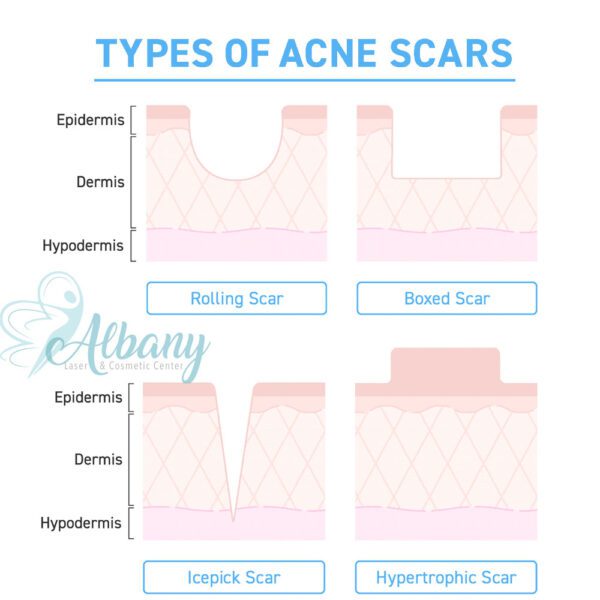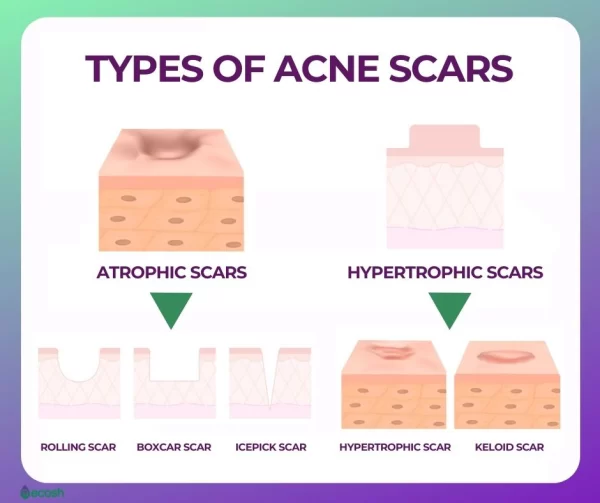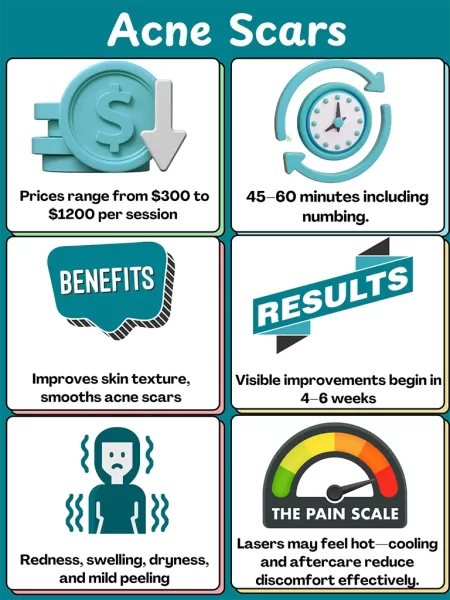Rolling Acne Scars in Edmonton: Classification, Treatments, Aftercare and More
Rolling acne scars form as your skin heals from inflammatory acne. Unlike sharp, narrow “ice‑pick” scars or the box‑shaped depressions of boxcar scars, rolling scars create shallow pits with sloping edges that give the skin a wavy texture. They often arise on thicker skin, such as the lower cheeks and jawline, and can span four to five millimetres in width. While they aren’t dangerous, rolling scars may affect self‑confidence and become more noticeable as you age. Thankfully, a variety of professional treatments can smooth these indentations, stimulate collagen and restore an even complexion.
Real Treatment Results and Patient Photos


Rolling Scar Treatment Summary
Cost & Pricing
What To Expect
Mechanism of Action
Benefits & Results
Discomfort & Pain Level
Side Effects & Downtime

What Are Rolling Acne Scars?
Rolling scars are part of the atrophic family of acne scars—indentations caused by the loss of collagen during healing.
These scars feature gentle, sloping edges that give the skin a wavy or undulating appearance. They are tethered to deeper structures by fibrous bands, causing the skin to “roll” when facial muscles move.
Severity:
• Mild – hard to see from 50 cm or covered with makeup
• Moderate – visible but flatten when stretched
• Severe – remain visible even when stretched
Why Do Rolling Scars Form?
These scars often follow prolonged or severe acne. When inflammation destroys collagen and fat, the skin heals inward. Persistent inflammation encourages fibrous bands to form between the skin and underlying tissue, tethering the scar down.
Contributing factors include squeezing pimples, delayed healing, smoking, and hormonal influences. While scars can soften over time, they usually do not resolve without treatment.
Effective Treatments for Rolling Scars
Why Choose Albany Cosmetic & Laser Centre for Rolling Scar Treatment?
- Microneedling with subcision: $500–$1,000 per session
- Fractional laser treatments: $800–$1,200 each
We’ll provide a personalized quote during your consultation and go over financing and membership options to fit your budget.
The Rolling Scar Treatment Procedure at Albany
Preparing for Your Treatment
Before your appointment, avoid direct sun exposure and tanning beds for at least a week. Discontinue use of retinoids or exfoliating products that may irritate the skin. Do not pick at active blemishes and arrive at the clinic with a clean, makeup-free face. If you are taking medications that affect bleeding, notify your provider in advance.
What to Expect During the Procedure
Your treatment experience will vary based on the chosen procedure:
- Microneedling: Numbing cream is applied, followed by a precision device that creates controlled micro-channels.
- Subcision: A needle is used beneath the scar to release fibrous bands; dermal filler may be injected afterward.
- Chemical Peels & Laser: These are performed under close supervision for precise, even results.
Most sessions last 30–60 minutes, and you’ll be able to relax comfortably throughout.
Aftercare and Recovery
Proper aftercare maximizes results and reduces complications:
- Cleanse: Use a mild, fragrance-free cleanser twice daily.
- Sun Protection: Wear SPF 30+ and a hat outdoors.
- Moisturize: Keep the skin hydrated with gentle, non-active moisturisers.
- No Picking: Do not pick or peel skin to avoid scarring and infection.
- Avoid Heat: No saunas, hot tubs, or intense workouts for 48 hours.
- Delay Makeup: Wait 24 hours before applying makeup; use non-comedogenic products.
- Stay Hydrated: Drink water and eat nutrient-rich foods to support healing.
- Follow Instructions: Use prescribed products and report any unusual symptoms (pain, swelling, discharge, fever) immediately.
Who Is a Good Candidate for Rolling Scar Treatment?
Rolling scar treatments are suitable for adults who:
- Have mild to moderate rolling scars from acne.
- Are in good overall health and free of active skin infections or uncontrolled acne.
- Are not pregnant or breastfeeding.
- Have realistic expectations and are committed to multiple sessions if needed.
- Can protect their skin from the sun and follow aftercare instructions.
Individuals with severe scarring or underlying medical conditions may require surgical interventions or specialist referral. We’ll help you determine the best approach during your consultation.
Request Your Appointment Today
Request your consultation today and discover how our treatment can refresh your appearance.
Call us at (587) 520‑2835 or use our online booking form to schedule an appointment.
Read our privacy policy here
Combining Rolling Scar Treatment with Other Procedures
For optimal results, rolling scar treatments are often combined with complementary procedures:
- Subcision plus fillers: Releasing the scar and immediately lifting it with a filler provides both immediate and long‑term improvements.
- Microneedling with platelet‑rich plasma (PRP): Adding PRP enhances collagen production and speeds healing.
- Laser resurfacing and chemical peels: Alternating these treatments can smooth texture and improve pigmentation.
- Topical skincare: Medical‑grade serums, retinoids and antioxidants support ongoing skin health between procedures.
During your consultation, we’ll design a combination plan tailored to your skin type, scar severity and lifestyle.
Related Services at Albany Cosmetic & Laser Centre
There are three types of microdermabrasion: mechanical, chemical, and laser.
Mechanical microdermabrasion uses a hand-held device that has a rough surface to rub off the top layer of skin. Chemical microdermabrasion uses a gel or cream with glycolic or other acids to remove the dead skin cells. Laser microdermabrasion uses a laser to vaporize the top layer of skin cells.
Microdermabrasion is considered safe for most people; however, those with active acne or rosacea may aggravate their condition if they undergo this procedure. People with very dark skin may also experience lightening of the skin after microdermabrasion.
Microdermabrasion treatments typically last between 30 and 60 minutes. A series of treatments is often recommended for optimal results. The cost for each treatment can range from $75 to $200